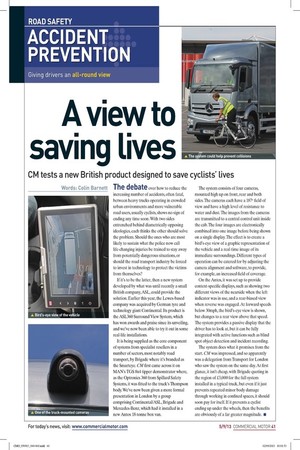A view to saving lives CM tests a new British product designed to save cyclists lives Words: Colin Barnett
Page 33

If you've noticed an error in this article please click here to report it so we can fix it.
The debate over how to reduce the increasing number of accidents, often fatal, between heavy trucks operating in crowded urban environments and more vulnerable road users, usually cyclists, shows no sign of ending any time soon. With two sides entrenched behind diametrically opposing ideologies, each thinks the other should solve the problem. Should the ones who are most likely to sustain what the police now call life-changing injuries be trained to stay away from potentially dangerous situations, or should the road transport industry be forced to invest in technology to protect the victims from themselves?
If it's to be the latter, then a new system developed by what was until recently a small British company, ASL, could provide the solution. Earlier this year, the Lewes-based company was acquired by German tyre and technology giant Continental. Its product is the A5L360 Surround View System, which has won awards and praise since its unveiling, and we've now been able to try it out in some real-life installations.
It is being supplied as the core component of systems from specialist resellers in a number of sectors, most notably road transport, by Brigade where it's branded as the Smarteye. CM first came across it on MAN's TGS 8x4 tipper demonstrator where, as the Optronics 360 from Spillard Safety Systems, it was fitted to the truck's Thompson body. We've now been given a more formal presentation in London by a group comprising Continental/ASL, Brigade and Mercedes-Benz, which had it installed in a new Antos 18-tonne box van.
The system consists of four cameras, mounted high up on front, rear and both sides. The cameras each have a 187° field of view and have a high level of resistance to water and dust. The images from the cameras are transmitted to a central control unit inside the cab. The four images are electronically combined into one image before being shown on a single display. The effect is to create a bird's-eye view of a graphic representation of the vehicle and a real-time image of its immediate surroundings. Different types of operation can be catered for by adjusting the camera alignment and software, to provide, for example, an increased field of coverage.
On the Antos, it was set up to provide context-specific displays, such as showing two different views of the nearside when the left indicator was in use, and a rear-biased view when reverse was engaged. At forward speeds below 30mph, the bird's-eye view is shown, but changes to a rear view above that speed. The system provides a passive display that the driver has to look at, but it can be fully integrated with active functions such as blind spot object detection and incident recording. The system does what it promises from the start. CM was impressed, and so apparently was a delegation from Transport for London who saw the system on the same day. At first glance, it isn't cheap, with Brigade quoting in the region of £3,000 for the full system installed in a typical truck, but even if it just prevents repeated minor body damage through working in confined spaces, it should soon pay for itself. If it prevents a cyclist ending up under the wheels, then the benefits are obviously of a far greater magnitude. •









































